Peter Arashiro, Learning Experience Designer
@PeetrPiper
Rebecca M. Quintana, PhD, Learning Experience Design Lead
@rebquintana
Yuanru Tan, Learning Experience Designer and Accessibility Coordinator
@YuanruTan
At the University of Michigan and on campuses across the country, the fall term is in full swing. While students and faculty turn their attention to their new schedules, you can still hear conversations about “what I did this summer” and at the Center for Academic Innovation, we are no different.
A handful of our staff recently wrapped-up a professional learning opportunity called the “Summer MOOC Adventure” where they accepted the mission of exploring courses on the digital learning platform, FutureLearn. These staff were in search of innovative content, innovative assessments, and innovative interactions.
The University of Michigan has well-established relationships with Massive Open Online Course (MOOC) platforms, Coursera and edX, and have reached more than 8 million learners in more than 190 countries around the world since the university offered its first MOOC in 2012. We have not only learned what makes for effective online learning experiences, but we’ve also learned that the MOOC platforms themselves can shape different types of interactions. From the cross-platform comparison study the Learning Experience Design team recently conducted, we learned that learners engaged differently in online discussions despite taking the same course hosted on both Coursera and edX. As we start to explore the question of what it means to design a course on FutureLearn platform, we are excited about the possible online learning experiences in this journey.
How Did We Kick Off the MOOC Adventure?
In early June, the Learning Experience Design team gave a brief presentation where we reflected on courses we had taken on FutureLearn and proposed three dimensions of course design for our fellow adventurers to focus on as they took their courses: 1) innovative content, 2) innovative interaction, and 3) innovative assessment. For each design dimension, we provided a list of questions to guide adventurers as they explored their courses. For example:
- What types of opportunities are available for learners to select from a variety of content?
- What type of feedback learners receive (e.g., automated or human; instructor or peer)?
- What types of opportunities are there for learners to act as more knowledgeable than others or facilitators?
With a shared understanding of these three dimensions, each adventurer enrolled in a FutureLearn course that interested them. A variety of topics emerged from our adventurers’ course selections, such as “Fairy Tales: Meanings, Messages, and Morals,” “Why Numbers Matter: Quantitative Research,” “Understanding Depression and Low Mood in Young People,” and “The Art of Teaching Foreign Languages to Young Learners.”

What “Moooved” Us?
In late August, we wrapped-up our adventure by bringing adventurers together to hear about their learning experiences. We were interested in the following reflections:
- What did adventurers like and dislike about their courses? What surprised them?
- What learning design practices should we consider adopting across all learning experiences? What practices should we not adopt?
- Which of University of Michigan’s MOOCs should we consider offering on FutureLearn?
Across the three dimensions (innovative content, innovative interactions, innovative assessments), there were more positive experiences reported around innovative interactions compared to the other aspects. Given how much FutureLearn values social connection as a key to learning, this isn’t surprising. Adventurers reported enjoying the ability to “like” comments contributed by their classmates, as well as receiving “likes” on their contributions. Another feature adventurers noted was the ability to follow the contributions of specific classmates throughout the course.
In terms of what design practices should be adopted across multiple online learning experiences (not only those hosted on FutureLearn), adventurers appreciated content that was of great relevance and had high production value, such as videos that were shot at various locations relevant to the course, well-developed infographics, and downloadable resources that could be used in real-world settings. Adventurers also highlighted demonstrations and worked-examples by course instructors as design formats for the “to-be-adopted” list.
Going a step further, we asked our adventurers to compare the university’s portfolio of MOOCs offered through Michigan Online to FutureLearn’s portfolio. Did they see opportunities replicate any of our current offerings on FutureLearn? What new ideas for courses came to mind? Many agreed that courses where storytelling is inherent to the way content is conveyed, such as history, arts, and culture, would be good candidates. Courses with a heavy social interaction component was also mentioned.
We concluded our session by asking adventurers to share how they would describe their Summer MOOC Adventure in one sentence. It was interesting to see how each adventurer approached the start of their journey. While a majority took just one course, a few attempted more than one course at a time and quickly found out how difficult it was to maintain pace with multiple courses. Others on our team noted how convenient the compressed format of the courses fit into their summer schedule and others felt they became better teachers by stepping back into the role of a learner. Some felt a sense of accomplishment and appreciated this “excuse” to complete a MOOC.
All in all, we think all adventurers would agree that it is great to work in an environment where learning experiences, in all its forms, is studied formally and also approached with a genuine sense of curiosity and fun. Plus, we also love collecting really cool laptop stickers. (Special thanks to DaJaniere Rice for designing Summer MOOOOOC Adventure stickers!)



